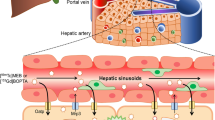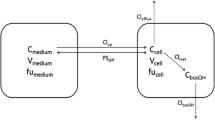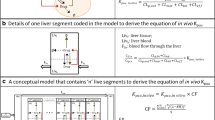Abstract
A new pharmacokinetic model is proposed to explain the hepatobiliary transport of a nonmetabolized sulfonic acid dye, bromphenol blue, which is actively transported from the bloodstream into bile. This model has the advantage of taking into account the roles of the liver cytoplasmic Y- and Z- binding proteins and T binder.
Similar content being viewed by others
References
W. A. Ritschel. Bioavailability in the clinical evaluation of drugs.Drug. Intell. Clin. Pharmacol. 6:246–256 (1972).
P. A. Harris and S. Riegelman. Influence of the route of administration on the area under the plasma concentration-time curve.J. Pharm. Sci. 58:71–75 (1969).
R. N. Boyes, H. J. Adams, and B. R. Duce. Oral absorption and disposition kinetics of lidocaine hydrochloride in dogs.J. Pharmacol. Exptl. Therap. 174:1–8 (1970).
D. G. Shand and R. E. Rangno. The disposition of propranolol. I. Elimination during oral absorption in man.Pharmacologia 7:159–168 (1972).
D. G. Shand, R. E. Rangno, and G. H. Evans. The disposition of propranolol. II. Hepatic elimination in the rat.Pharmacologia 8:344–352 (1972).
D. Perrier and M. Gibaldi. Influence of first-pass effect on the systemic availability of propoxyphene.J. Clin. Pharmacol. 12:449–452 (1972).
K. Takada, Y. Mizobuchi, and S. Muranishi. Biopharmaceutical study of the hepatobiliary transport of drugs. I. Hepatobiliary transport of non-metabolizing organic anionic compounds in rat.Chem. Pharm. Bull. (Tokyo) 22:922–929 (1974).
K. Takada, M. Ueda, M. Ohno, and S. Muranishi. Biopharmaceutical study of the hepatobiliary transport of drugs. II. Roles of the liver cytoplasmic Y and Z binding proteins and T binder on the hepato-biliary transport of organic anionic compounds.Chem. Pharm. Butt. (Tokyo) 22:1477–1486 (1974).
A. J. Levi, Z. Gatmaitan, and I. M. Arias. Two hepatic cytoplasmic protein fractionsY andZ and their possible role in the hepatic uptake of bilirubin, sulfobromophthalein, and other anions.J. Clin. Invest. 48:2156–2167 (1969).
W. J. O'Reilly, P. E. Coates, K. A. McMahon, E. Ting, and B. G. Priestly. Pharmacokinetic models for the biliary excretion of amaranth in the rat.Life Sci. 11:197–208 (Part I), (1972).
G. L. Atkins. A versatile digital computer programme for non-linear regression analysis.Biochim. Biophys. Acta 252:405–420 (1971).
G. Czok and H. G. Dammann. Evidence of absorption of bromosulphthalein from the biliary system of the rat.J. Pharm. Pharmacol. 24:820–821 (1972).
J. A. Nelson, L. Z. Benet, and H. I. Goldberg. Absorption of iodipamide from the biliary system of the rabbit.J. Pharm. Pharmacol. 24:993–995 (1972).
R. E. Peterson and J. M. Fujimoto. Retrograde intrabiliary injection: Absorption of water and other compounds from the rat biliary tree.J. Pharmacol. Exptl. Therap. 185:150–162 (1973).
J. G. Wagner, P. G. Welling, and A. J. Sedman. Plasma concentrations of propoxyphene in man. II. Pharmacokinetics.Internat. J. Clin. Pharmacol. Therap. Toxicol. 5:381–388 (1972).
K. Winkler. The kinetics of elimination of bromosulphthalein in man after single injections, and continuous infusion. In W. Taylor (ed.),The Biliary System, Blackwell, Oxford, 1965, pp. 551–566.
T. G. Richards. The plasma concentration of bromosulphthalein after single intravenous injection in normal and abnormal human subjects. In W. Taylor (ed.),The Biliary System, Blackweil, Oxford, 1965, pp. 567–579.
L. Z. Benet and J. S. Turi. Use of general partial fraction theorem for obtaining inverse Laplace transforms in pharmacokinetic analysis.J. Pharm. Sci. 60:1593–3594 (1971).
Author information
Authors and Affiliations
Rights and permissions
About this article
Cite this article
Takada, K., Muranishi, S. & Sezaki, H. Pharmacokinetics of the hepatobiliary transport of bromphenol blue as a model of organic anionic compounds. Journal of Pharmacokinetics and Biopharmaceutics 2, 495–509 (1974). https://doi.org/10.1007/BF01070944
Received:
Revised:
Published:
Issue Date:
DOI: https://doi.org/10.1007/BF01070944




